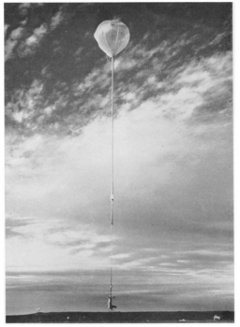Stratoscope II Before Launch: The Stratoscope II night-time observatory on the ground prior to launch. For more information about Stratoscope II, see Danielson, R. E., AmSci, 51, 375.
Credit: Image courtesy American Scientist
Following the great success of Stratoscope I in the late 1950s to obtain extremely detailed images of phenomena occurring in the solar atmosphere, Schwarzschild and Robert Danielson decided to pursue the much more ambitious Stratoscope II project. Stratoscope II was basically a balloon-borne predecessor to the Hubble Space Telescope. Stratoscope II was a night-time, fully remote-controlled observatory, consisting of a reflecting telescope with a precisely figured 0.9-meter mirror which focused light into a complex optical system designed to obtain very high angular resolution images of celestial objects including planets and galaxies. The telescope, suspended from a balloon and flown to an altitude of 80,000 feet for night-time observing, was not above the entire atmosphere. But, it was above the convecting layers of the atmosphere that blur the images of light passing through to ground-based telescopes. Stratoscope II was thereby able to obtain extremely clear images of planets and galaxies. In all, there were eight flights of Stratoscope II extending from 1963 to 1971. The first two flights were not imaging flights; they were designed for infrared observations and to get the whole system to work.
Stratoscope II After Launch: At launch, the heavy-lift launch balloon is inflated above the uninflated main balloon. The observatory is 660 feet tall at launch. For more information about Stratoscope II, see Danielson, R. E., AmSci, 51, 375.
Credit: Image courtesy American Scientist
The technical challenges faced by the pioneers of space astronomy were considerable. This included gaining reliable access to the space environment, developing light weight optical systems, developing pointing and control systems, and developing sensitive detectors of the radiation. The most difficult challenge was to design and build a complex robotic system that would actually operate in the space environment.
The progression through these various technological challenges did not always proceed smoothly. As a beginning graduate student at Princeton in 1964, I witnessed the space astronomy activities involving pioneering projects in UV spectroscopy through the efforts of Don Morton and Lyman Spitzer and in high resolution imagery in the Stratoscope II project. I vividly remember discussions in the halls about sounding rockets blowing up on the launch pad, pointing and control systems that failed to operate, and parachute systems that deployed too early.
In the case of Stratoscope II, there were two flights where the telescope system failed to unlatch from the vertical launch position at altitude and one flight where the primary mirror door failed to open at altitude. Reflecting on all of these problems and wondering how long it might take to complete an experimental Ph.D. thesis in the young field of space astronomy, I made an arrangement with Robert Danielson and Martin Schwarzschild to pursue a theoretical Ph.D. thesis and to then join the Stratoscope II program after graduation as a postdoctoral researcher. That was a good decision. I even learned what it was like to be a theoretical astrophysicist.



